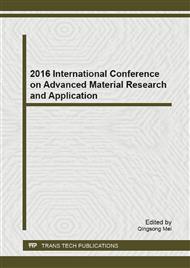[1]
N. Pewnim, S. Roy, Electrodeposition of tin-rich CuSn alloys from a methanesulfonic acid electrolyte, Electrochimica Acta, 90 (2013) 498-506.
DOI: 10.1016/j.electacta.2012.12.053
Google Scholar
[2]
Caterina Zanella, Sujie Xing, Flavio Deflorian, Effect of electrodeposition parameters on chemical and morphological characteristics of CuSn coatings from a methanesulfonic acid electrolyte, Surface and Coatings Technology. 236 (2013) 394-399.
DOI: 10.1016/j.surfcoat.2013.10.020
Google Scholar
[3]
Gongjun Cui, Qinling Bi, Shengyu Zhu, et al, Tribological properties of bronzegraphite composites under sea water condition, Tribology International. 53 (2012) 76-86.
DOI: 10.1016/j.triboint.2012.04.023
Google Scholar
[4]
Majid Asnavandi, Mohammad Ghorbani, Mohaddeseh Kahram, Production of CuSngraphiteSiC composite coatings by electrodeposition, Surface and Coatings Technology. 216 (2013) 207-214.
DOI: 10.1016/j.surfcoat.2012.11.042
Google Scholar
[5]
L.N. Bengoa, W.R. Tuckart, N. Zabala, et al, Bronze electrodeposition from an acidic non-cyanide high efficiency electrolyte tribological behavior, Surface and Coatings Technology. 253 (2014) 241-248.
DOI: 10.1016/j.surfcoat.2014.05.046
Google Scholar
[6]
Lixia Ying Zhenghui Li Guannan Liu, et al, Study on the effect of TiO2 nanoparticles on the microstructure and properties of Ni- PTFE coating, Functional Materials. 6 (2015) 31-34.
Google Scholar
[7]
Sangeetha S, Kalaignan G P, Anthuvan J T, Pulse electrodeposition of self-lubricating NiW/PTFE nanocomposite coatings on mild steel surface, Applied Surface Science. 359 (2015) 412-419.
DOI: 10.1016/j.apsusc.2015.10.127
Google Scholar
[8]
Balaji R, Pushpavanam M, Kumar K Y, et al, Electrodeposition of bronzePTFE composite coatings and study on their tribological characteristics, Surface and Coatings Technology. 201 (2006) 3205-3211.
DOI: 10.1016/j.surfcoat.2006.06.039
Google Scholar
[9]
Chaojun Du, Xinling Li, Jiaxiang Yang, et al, Electrodeposition of coppernickeltinpolytetrafluoroethylene composite coating and its properties, Electroplating & Finishing. 34 (2015) 1391-1394.
Google Scholar
[10]
Zhirong Huang, Panyu Li, Effect of process parameters during preparating Cu-Sn-PTFE self-lubricant composite coating by electrodeposition method on its properties, Materials for Mechanical Engineering. 11 (2011) 78-81.
Google Scholar


